Visitors saunter from Kabanbay Batyr Street—Almaty, Kazakhstan’s “Broadway”—into the new Tselinny Center of Contemporary Culture designed by Asif Khan. The building serves as a terminus on the historic axis speckled with trees and Brutalist, Socialist Realist, and Constructivist buildings, some by Moisei Ginzburg.
Lamellas adorn the facade facing Kabanbay Batyr Street (one in every five of the ribs is structural) while the north and south elevations are more abstract, featuring luminescent, nebulous, dreamy inset shapes inspired by the late artist Yevgeniy Sidorkin, whose sgraffito adorns the Tselinny Center’s cavernous foyer. Khan likened the overall ensemble to “fragments of the memory of a memory” on a recent visit to Almaty.
Outside Tselinny Center, the plaza’s gentle curvature mimics the Central Asian steppe’s rolling hills; one can hear running water from a nearby aryk, a shallow channel next to the sidewalk that helps cool Almaty in the hot months. An elementary school sits across the street.
Kazakhstan’s first private cultural institution is located within a former Soviet cinema that was adaptively reused by Khan—Kazakh architect Zaure Aitayeva was the project lead. (Khan and Aitayeva are married; they met in Kazakhstan when Khan was designing the U.K. Pavilion at Expo 2017 in Astana.) NAAW, a local Almaty office, was behind the cafe design and served as architect of record.
The Tselinny Center of Contemporary Culture is both a deeply contextual and forward-looking building: Architects looked to the landscape and history of Kazakhstan to make decisions infused with nomadic cosmologies. Khan frequently invokes tengri (sky) and umai (earth) when describing Tselinny Center’s formalist qualities, at the same time employing contemporary building technologies and decolonial aesthetic theory.
“There’s a connection to a past that we can’t get back to,” Khan said, when describing the elevations. “Symbols can transport us. These shapes are familiar to everyone who knows this place. But now they’re open to interpretation. It’s a language from the past that we don’t fully understand.”
Tselinny Cinema Center
Before it was Tselinny Center, it was Tselinny Cinema—a Soviet movie theater completed in 1964. The building plan was simple: A plaza led visitors into a grand foyer which fed into a cavernous screening room; a curtain wall fronted the street.
Tselinny Cinema has historically been credited to architect Vladimir Katsev—the same designer behind Almaty Circus (1972) and Medeu Ice Skating Rink (1972)—although Katsev’s daughter, actress Marianna Pokrovskaya, disputes this claim: Pokrovskaya said the architect of Tselinny Cinema was in fact Savely Rosenblum, based in Tashkent, Uzbekistan.
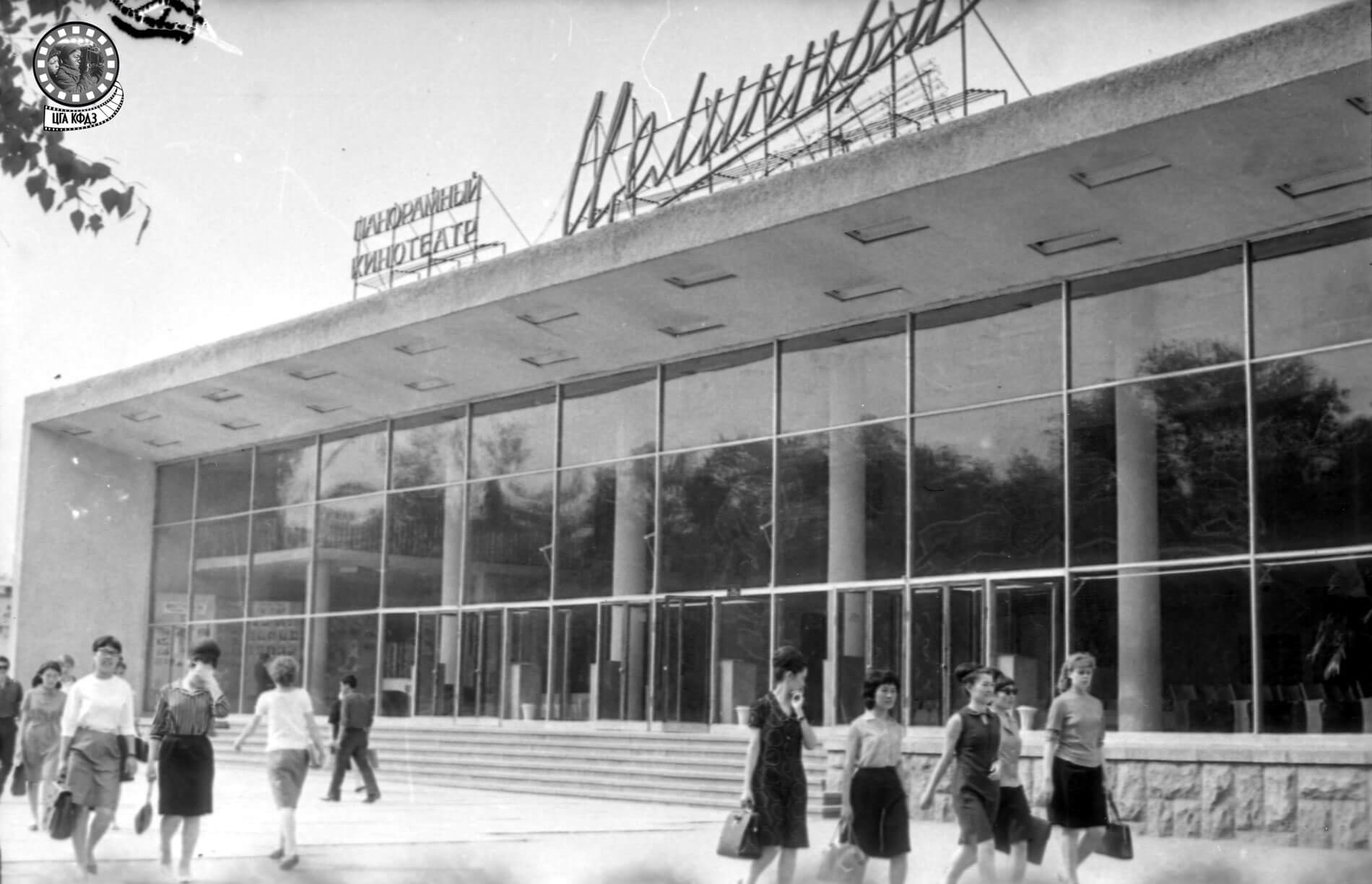
The 1,600-seat cinema anchored Proletarskaya Square and was designed to overshadow a Russian Orthodox cathedral; the movie hall was built just tall enough to cut off the church’s south-facing light.
Its expansive glazing overlooking Kabanbay Batyr Street, according to architect Zhanna Spooner, spoke to a moment remembered in Soviet artistry as the “Khrushchev Thaw,” when Stalinist restrictions on film, architecture, and culture were lifted. (Think: Marlen Khutsiev’s I Am Twenty, Khutsiev’s July Rain, or Kira Muratova’s Brief Encounters.)
In this vein, Sidorkin’s sgraffito in the foyer offered a charming vignette of figures wearing traditional Kazakh garb: Women are pictured reading in a field and playing a dombra, a 2-string lute that was historically reserved for men. Thus, the artwork is a nod to literacy campaigns and increased freedoms under state socialism.
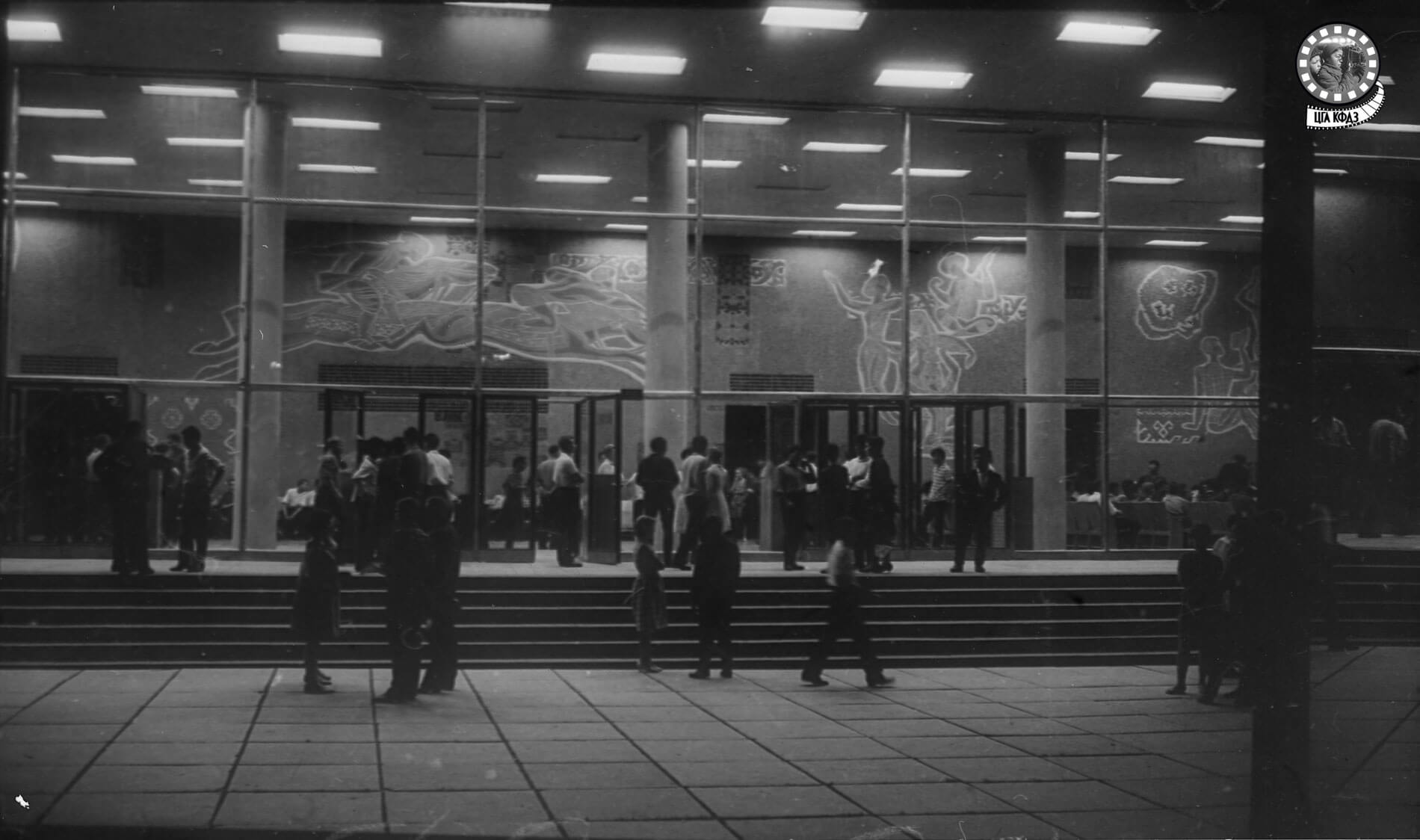
The word “Tselinny” is a derivation of the Russian word “tselina,” which means “uncultivated, virgin land.” Tselinny likewise denotes a Soviet agricultural campaign launched under the aegis of Nikita Khrushchev in the 1950s, resulting in the widespread spoliation of territory long considered sacred to Kazakhs, Uzbeks, Tajiks, and Kyrgyz.
Tselinny Cinema was later privatized during perestroika, and then took on a handful of ulterior uses. Entrepreneur Bauyrzhan Ibragimov bought the building and turned Tselinny into a sofa store, a restaurant, and even a night club (first “Heaven,” and then “Playboy”). He also covered up the bespoke sgraffito by Sidorkin with drywall, badly damaging much of it.

Kairat Boranbayev, a Kazakh venture capitalist, purchased Tselinny Cinema in 2015. Three years later, he founded the Tselinny Center of Contemporary Culture. That same year, in 2018, Boranbayev partnered with Moscow’s Garage Museum of Contemporary Art to stage an exhibition about the venue, curated by Ekaterina Golovatyuk and Giacomo Cantoni, the same team behind the Uzbekistan Pavilion at this year’s Venice Biennale.
The iconic neon sign that said “Tselinny” was removed from the main facade facing Kabanbay Batyr Street in the 2000s, but a temporary replica was installed as part of the 2018 exhibition. The venue’s name was ultimately kept the same, although it underwent significant adaptations. Exterior steps for instance were detached from the old cinema to make for a more accessible means of egress, creating what Khan called a “universal plane of movement.”
Jamilya Nurkalieva, Tselinny Center director, said the decision to keep the name the same arrived after long debates between architects, curators, and the public. Nurkalieva also said that part of Tselinny’s goal is enhancing what’s already there. “We say ‘enhance’ because artist communities already exist here. It’s a very big artist scene,” Nurkalieva told AN in Almaty over coffee, at the cafe designed by NAAW. “I would say it’s the largest scene in Central Asia.”
Nurkalieva added: “We are a horizontal institution. We don’t have a chief curator. We have, let’s call it, a core team of art managers. Everyone’s responsible for the projects.”
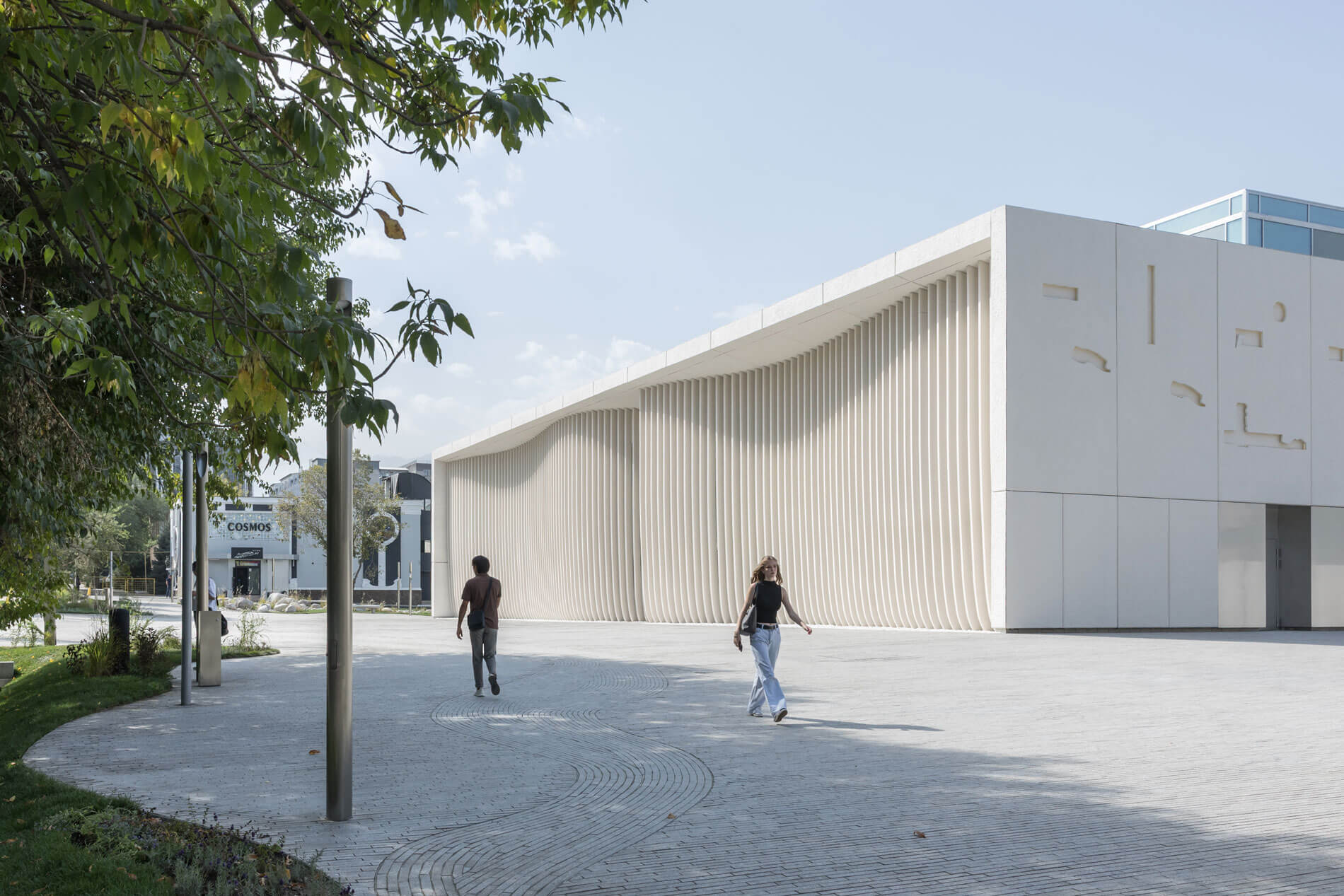
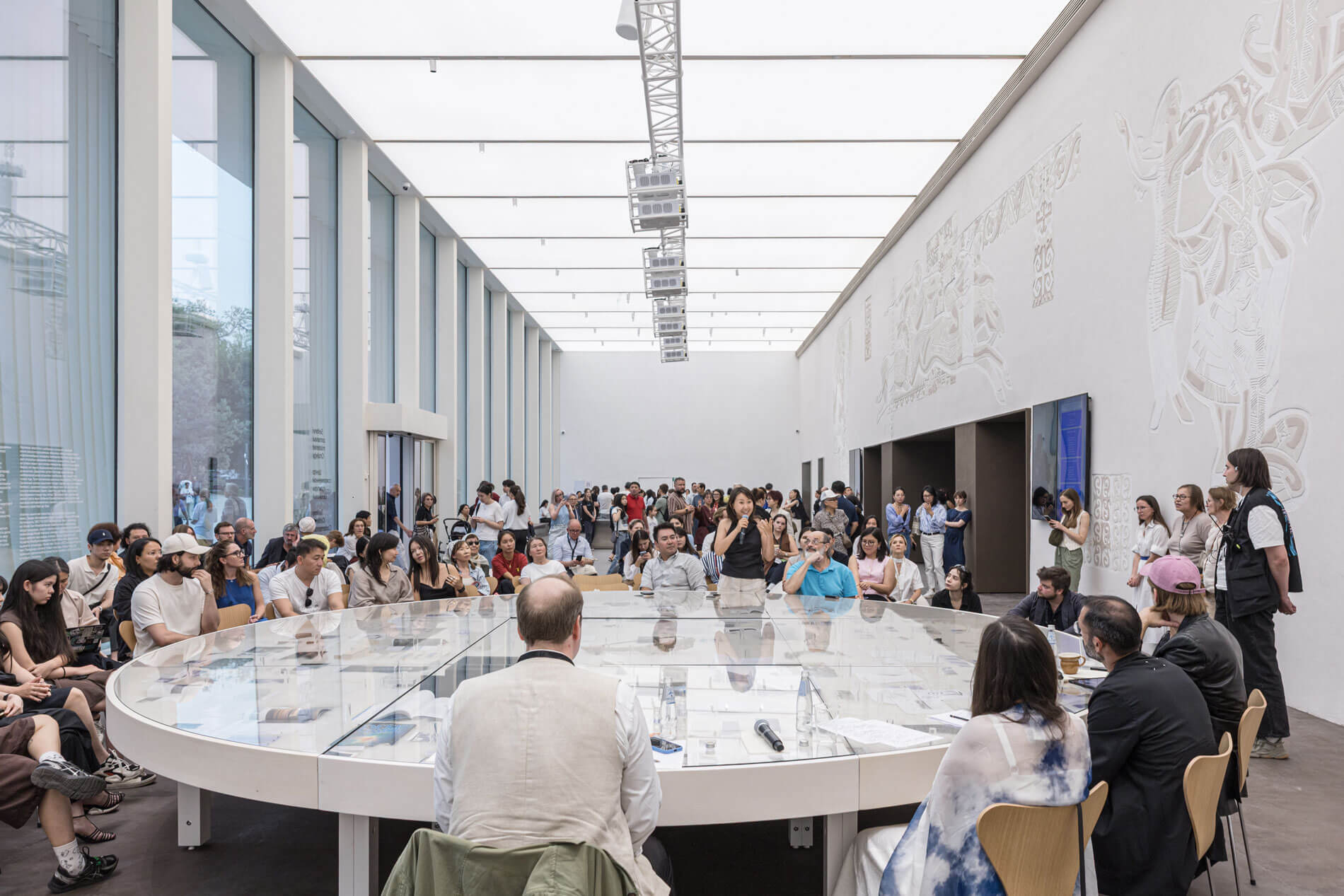
From Sky to Earth
This horizontal curatorial approach distinguishes Tselinny from other international cultural institutions of its caliber. Another differentiating factor: Nurkalieva and Boranbayev never formulated a brief to give Khan. Rather, when they began working with the architect almost a decade ago, the design emerged organically, and without any preconceived notions.
The peripatetic design process is encapsulated in an exhibition now on view at Tselinny, From Sky to Earth and How It Is Made, curated by historian Markus Lähteenmäki, who has been working with Khan since he was shortlisted for the never-realized Guggenheim Helsinki.
“The idea to do an exhibition about the design process,” Lähteenmäki told AN, “was to open up the complexity of the thinking, and how it reflects and resonates through the architecture. For me, it was an interesting opportunity to look at his practice from the outside.”
Lähteenmäki continued: “The exhibition’s subtitle [and How It Is Made] invokes Boris Eikhenbaum’s classic text from 1920, How Gogol’s Overcoat Was Made, which uses material language to analyze formal process.”
Other artworks at Tselinny Center engage with the virgin land campaign that terraformed the Aral Sea, a waterbody that Kazakhstan and Uzbekistan share. During the campaign, the Aral Sea shrunk by 90 percent, an ecological disaster the neighboring countries still reckon with today. At Tselinny Center, a multifaceted program, titled Barsakelmes, convened scholars, curators, performers, and artists to explore this history.
Gulnur Mukazhanova, Dariya Temirkhan, SAMRATTAMA, and qazaq indie conducted an avant-garde performance attended by AN, as part of the program. Such an undertaking is only possible at a space like Tselinny Center, where a massive cinema hall was carved out and converted into a vast open volume for experimental auditory art that demands lots of space in multiple vectors.
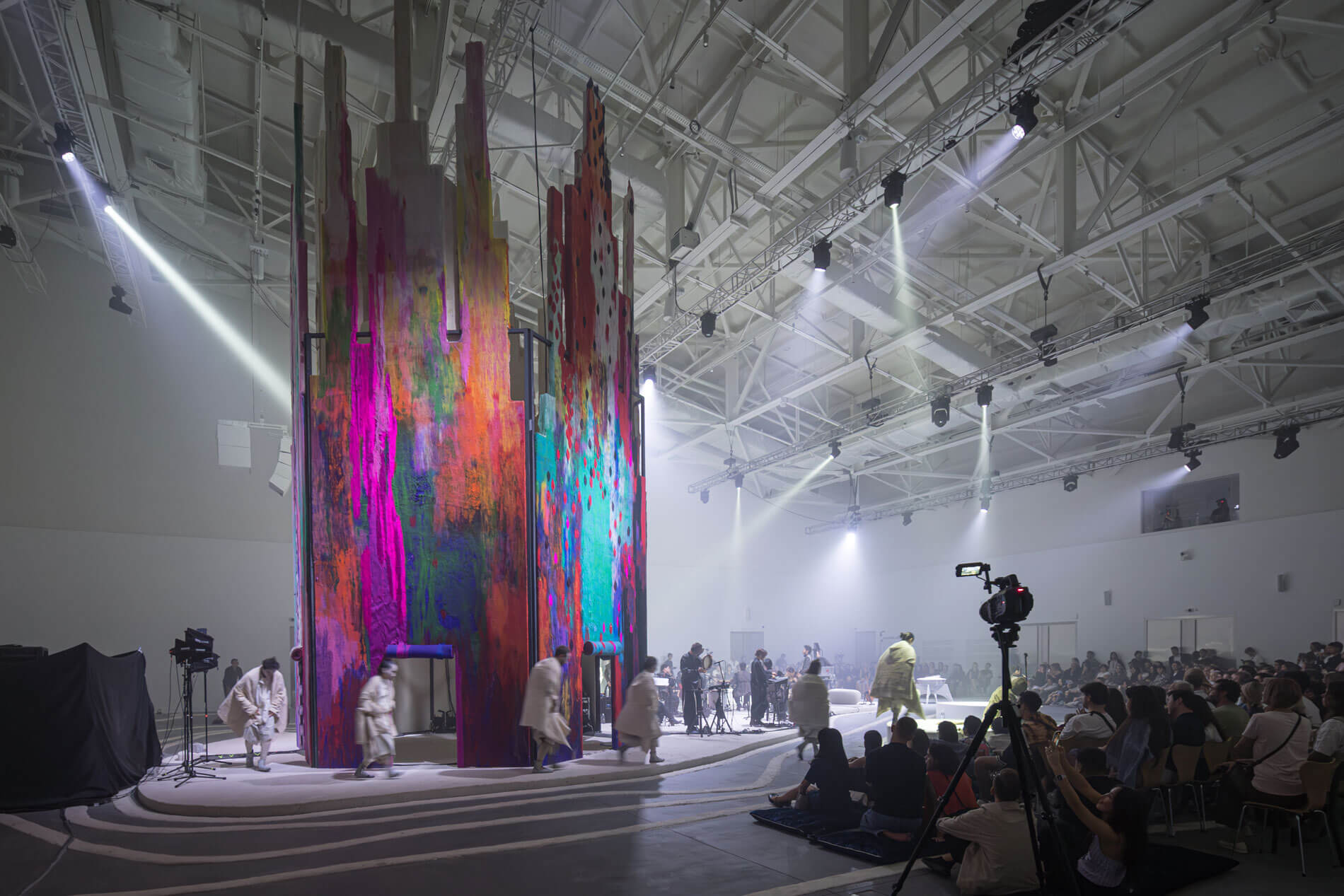
Soon, a new exterior cafe sited above the foyer will open. The cafe will be named after Kazakh actress Gulfairus Ismailova, the wife of Sidorkin. Khan worked closely with Vadim Sidorkin, their son, on the sgraffito’s rehabilitation. “We felt that we needed to remind people of her existence, and we needed to place her in the highest point of the building as the spirit and the soul,” Khan said.
Such Places as Memory
Khan, Aitayeva, Nurkalieva, and Boranbayev penultimately faced typical questions architects often grapple with when negotiating Soviet buildings in a post-Soviet world: What should be kept? And what should be made anew?
Nurkalieva described Tselinny Center as a careful curation of architecture and memory, not unlike other contemporary projects in the former Soviet bloc. In Kyiv, Ukraine, for instance, Forma Architects recently converted a defunct Soviet pavilion into another stunning new cultural center that makes for an apt comparison.
Pavilion 13 was designed by S. S. Pavlovsky; it opened in 1967, roughly the same time as Tselinny. It’s located at Ukraine’s National Complex Expocenter (VDNG) and was meant to celebrate the Soviet Union’s coal mining industry.

Programmatically, Pavilion 13 and Almaty’s Tselinny Center share similar ambitions: Each was built to platform mixed media artists by adaptively reusing defunct Khrushchev-era Soviet buildings, although their architectural approaches differ vastly.
Whereas Khan made noticeable changes to Tselinny, Forma opted to keep Pavilion 13 almost identical to its true form—a proto-Miesian ensemble defined by exposed structural columns, situated on a short plinth, with expansive glazing.
Due west of Kazakhstan, across the Aral Sea, similar plans are underway in Tashkent by the Uzbekistan Art and Culture Foundation, under the tutelage of Gayane Umerova, to repurpose a handful of Soviet modernist buildings, namely the former Lenin Museum by Yevgeny Rozanov and Vsevolod Shestopalov, completed in 1970.
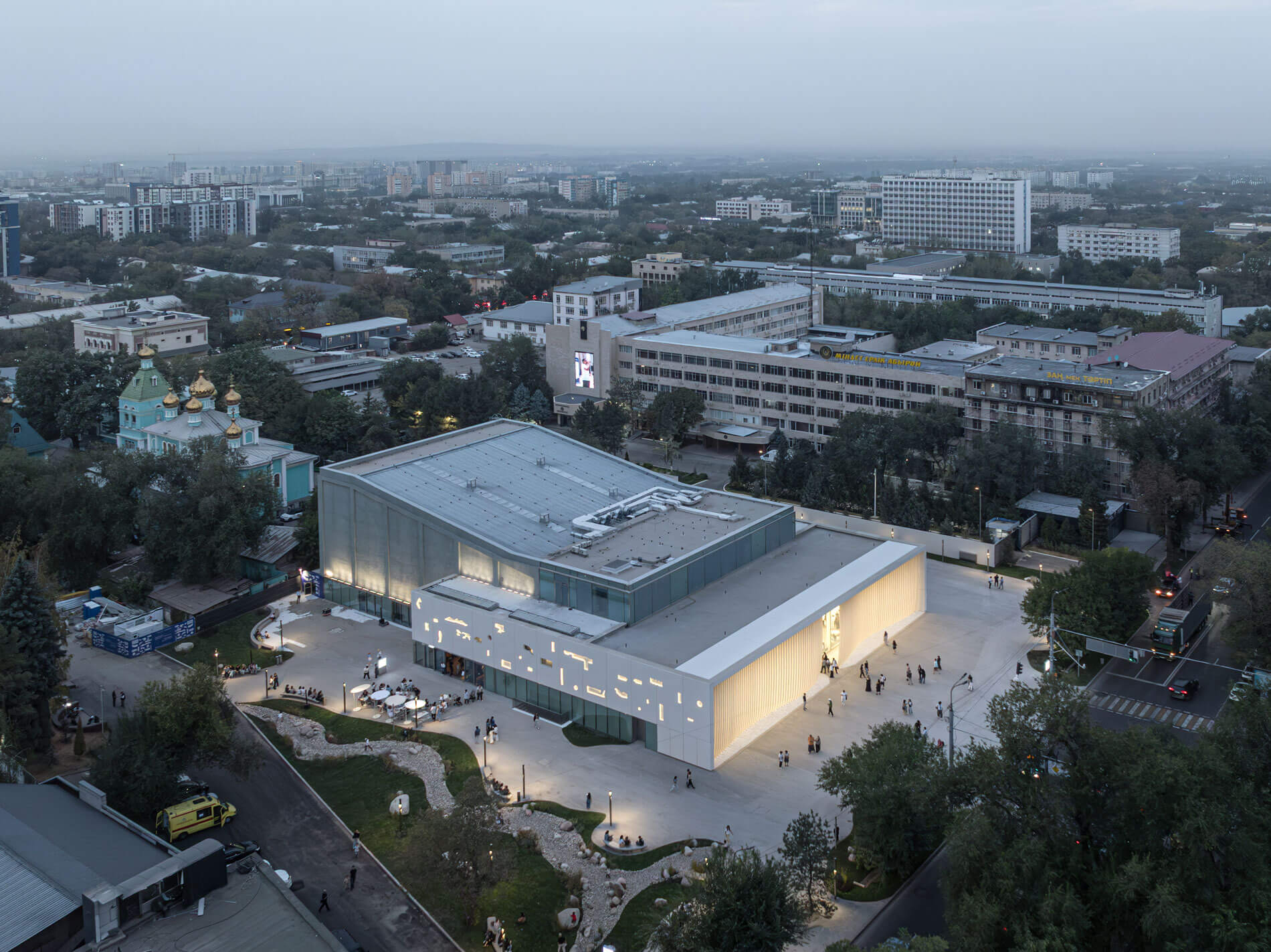
When viewed in its totality, the design by Asif Khan and company evades easy categorization: Certainly, Tselinny Center is an example of adaptive reuse, but it would be fallacious to call it parametricism, phenomenological, critical regionalism, or any other school critics often upcycle to describe novel buildings that it perhaps echoes.
Lähteenmäki agrees: “Phenomenological isn’t a word I would use. For me,” he said, “[Khan] is an architect of the 2000s, in the way he understands the power and use of images. He works with grand gestures. He wanted to bring the feeling, and the idea, and the scale of the steppe, the sky, and the clouds to Tselinny.”
Correction: A previous version of this article credited NAAW as the landscape architect. The article was updated on September 20.
→ Continue reading at The Architect's Newspaper
